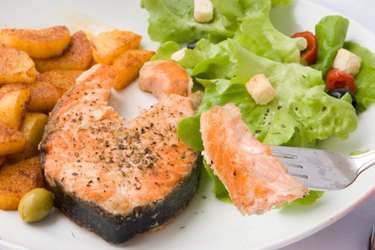
Seafood markets designate salmon as being wild, wild-caught or farmed. Each of these terms has a commonly accepted meaning based on the life cycle of the salmon. Most jurisdictions monitor and control the numbers of each type of salmon caught, both by commercial and recreational fishermen. All species of salmon may have any of these designations attached to them.
Fishing Wild Salmon
Video of the Day
Wild salmon have not had their life cycle interrupted or manipulated by humans. These fish have hatched from spawned eggs in native streams or rivers, and grew to maturity in rivers and oceans. Wild salmon are always native to the area in which they were caught.
Video of the Day
Wild salmon has a food source that consists of crustaceans, algae, plankton and vegetative sources that give the salmon's flesh a rich pink color. The amount of Omega-3 the fish contains depends on the type of algae and plankton they eat. The nutrients in the fish vary due to the fish's age and the availability of food during its life cycle.
Hatcheries Produce Wild-Caught Salmon
Fish hatcheries produce large numbers of young salmon, called fry, and release them into streams and rivers. These salmon are species native to the area, and complete the remainder of their natural life cycle after their release. A harvested salmon which had any portion of its life cycle manipulated by humans, including a hatchery birth, is designated as wild-caught. Wild-caught salmon are genetically very similar to wild salmon.
The Pacific Ocean produces most of the wild-caught salmon on the market. Harvesting season runs from June through September. A firm and less fatty fish than its cousin the farmed salmon, the wild-caught salmon are plucked from the water using nets, hand-lines, divers or traps.
Identifying Farmed Salmon
Salmon raised in confined areas, without living any portion of their life in the wild, are farmed fish. These fish may not be native to the area, and critics rate them as the lowest quality of the three types. Farmed salmon are prone to parasites such as sea lice, and the farming operations are potentially damaging to the local ecosystems.
Sourced from the Atlantic Ocean, farmed salmon are available most of the year. They are less expensive than wild or wild-caught salmon.
Marks on a Wild Salmon
Since wild and wild-caught salmon are often the same species, hatcheries typically mark each hatchery-raised fry. Hatcheries typically clip the adipose fin, a small fin on the top of the fish, of any young salmon born in captivity. This fin never grows back during the salmon's life, so the mark is permanent. Any fish with an intact adipose fin is likely to have hatched and grown without human intervention.
Nutritional Qualities of Salmon
There is evidence that wild and wild-caught salmon provides better nutrition than farmed fish, a result of different diets. Farmed fish may have a lower level of omega-3 oils, a beneficial oil found in salmon. Farmed salmon may also have higher levels of Polychlorinated Biphenyls (PCB), a carcinogen found in fish. Both farmed and wild salmon PCB levels are typically below the level considered hazardous to humans.
Future Trends For Salmon
Because of the pressure on natural fisheries, most salmon offered for sale in the United States is farm-raised. New farming techniques, including improved feed, have narrowed the gap between the quality of wild and farmed salmon. PCB levels are also changing in wild salmon, reducing the difference between farm-raised and wild salmon.